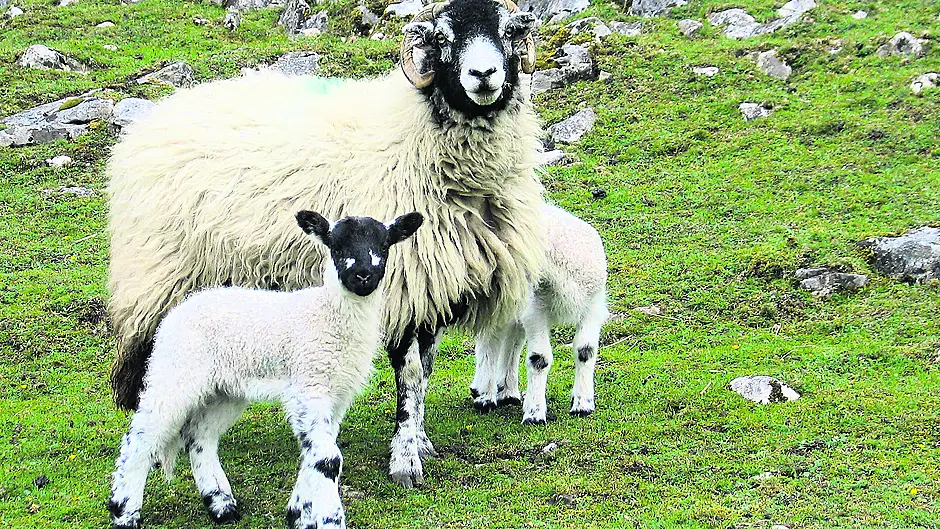THE recent good weather beckoned us all outdoors to enjoy the glorious sunshine and sent us off to Sheep’s Head. Everywhere we went there were lambs gambolling in the fields; throwing up their legs and leaping about in wild abandon, a sight which evokes pure joy.
Sheep are ubiquitous in our landscape but we pay them little heed. These gentle mammals have lived alongside us for thousands of years, giving us meat, milk, wool and other products. They are embedded in our myth and folklore and have been farmed for millennia in Ireland.
Early Ireland
Sheep were first domesticated in the Middle East around 10,000 years ago. Initially used for the meat they provided, they became even more valuable when breeds were created which could also produce wool.
The first sheep arrived in Ireland some 3,000-4,000 years ago. Brought here by Neolithic farmers, the early breeds looked more like goats than the sheep of today. These were small slim animals, brown with white underparts, with both sexes having horns.
Early Irish law tracts indicate that sheep in Ireland were valued more for their coat and hide rather than the meat they provided. Most of these early Irish sheep were black or brown.
Sheep with white fleeces were rare and were highly valued due to the suitability of their wool for dying. The Brehon Laws record white sheep as being two to three times more valuable than their darker counterparts.
These Early Irish Laws also give us information on how they were farmed here in that era. Unlike today, sheep were mainly kept on low ground rather than on hills and mountains. And, in those days, the job of the shepherd was to lead the sheep, not to drive them, as is the case today. Sheep dogs, too, played a different role as their primary function was to guard the sheep from wolves and other predators rather than round them up.
Sheep were farmed primarily to produce wool for clothing but they also had other uses in early Ireland. Sheepskins with the wool still attached were used for bedding, rugs and as ‘overcoats’.
Sheep’s milk was used to make cheese and its importance was celebrated on the Celtic festival of Imbolc in February. Mutton was also consumed, especially at weddings.
Sheep were also utilised as currency in the Brehon Laws. Like cattle, but representing a lower value, they were used to pay fines and settle payments. The hierarchical nature of this society can be seen in these law judgements. For example, the fine due to a noble man for a minor facial wound was a milch cow while the small landowner was paid a sheep for the same offence.
Myths and folklore
Sheep also feature in many Irish legends. The early Irish text ‘The Book of Invasions’ records that the first sheep were brought to Ireland by the daughter of Noah.
The great Irish god of the sea, Manannán, seemingly had seven sheep at his home in the Land of Promise. These legendary sheep were said to be able to produce enough wool to clothe all the men in the world.
And Conan, a bald Fianna warrior, had the skin stripped from his back while escaping from a seat where he had been held by magic. However, his wounds were subsequently healed by having a sheepskin fitted to his back. This skin remained there for the remainder of his years and even grew wool, while his head remained bald.
Legend has it that St Patrick prayed to Archangel Michael to restore the life of the son of the King of Ireland in the fifth century. When Patrick’s prayers were answered, the boy’s mother decreed that a sheep should be killed and its meat given to the poor on the feast of St Michael in gratitude. And this custom of killing an animal and giving portions of it to the poor at Michaelmas (29 September) lived on as a custom in Ireland.
In modern times, the only recorded native breed is the Galway Sheep and the future of this breed remains critical, although efforts to conserve it are ongoing.
Sheep today are mainly bred for their meat, particularly lamb, as the Irish wool industry has seen decades of steep decline. It would be a tragedy to see them disappear from our uplands so hopefully that trend will be reversed by new uses for wonderful Irish wool.
We can only hope that generations to come will also get to enjoy the sight of lambs happily leppin’ on our hills.










